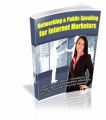Sample Content Preview
eBooks aren’t hard-selling documents. They usually take a short time to create, can be marketed easily, and are valuable to most audiences, whether they are B2B or B2C. They are cost-effective and easy to compile. For example, you can sassily create an eBook from previously written blog posts that tie together and deliver a message. You can include URLs and encourage your audience to get on your list, join your communities, and buy your products and use your services – all through eBooks.
These three content types are well-known yet subtle marketing tools that you need to use to ensure that your content marketing strategy will be successful. Plus, every single piece of marketing collateral you create can be reused, repurposed, and reformatted to increase the return on investment exponentially for all three types of long-form content marketing, while grabbing your audience’s attention and keeping it due to the design and information inside.
What Is Included in a White Paper?
A white paper is a datacentric multipage document that is written in a formal way, helping the reader understand the issue, solve their problems, or make the right choices. A white paper (sometimes written “whitepaper”) uses a lot of research and data to persuade the readers on behalf of a specific recommendation or solution.
A white paper is a great way to showcase your expertise and to market yourself to your audience without being in high pressured sales mode. Instead, you provide information that highlights the expertise, knowledge, and value of the solutions you are recommending.
Choosing Your Topic
When you decide that you want to create a white paper for marketing purposes and educational purposes for your business, it’s imperative that you first choose a good topic. Like anything else, when choosing a topic, you want to consider your audience and your expertise, and you want to create a white paper that is focused on the solution for the one specific problem that you’re highlighting within the white paper.
Preparing Your White Paper
A white paper needs to include a lot of data and research to make it a true white paper. Therefore, to prepare you need to conduct comprehensive research that includes references from internal documentation as well as industry resources that are authoritative in nature as well as reliable and credible. It will help to create a thorough outline or mind map (depending upon your preference) to ensure that you include all the information needed.
Formatting Your White Paper
The format of a white paper is consistent with most business reports and documentation, with the addition of a conclusion that is more of a recommendation at the end to guide readers toward making a purchase.
White papers take a considerable amount of time to research, develop, and complete. However, a good white paper can increase opportunities for your business and makes for great evergreen content that you can use throughout your content marketing efforts. This makes the hard work totally worth it in terms of your return on investment.
Sometimes the conclusion for a business report is written at the beginning of the document, but in the case of a white paper, the conclusion or thoughts and opinions of the writers are placed at the end. The final section is supposed to be the deciding moment for the reader, and the white paper takes the reader on a journey through awareness, consideration, and decision right in one report.
The main point is that you need to make your white paper persuasive and easy to understand for the reader. For this reason, you’ll need to format the document in an orderly way by choosing an accurate title, including an abstract or brief overview of the white paper’s main points, and so forth, which allows the reader to understand that this is the right document for them to read.
Then you need to state the problem and provide background information; all the original research, secondary research, and information should be communicated here. Finally, you’ll want to offer up the solution at the point of decision making, along with the major findings repeated in the conclusion. Of course, always provide a list of references. It helps to follow industry guidelines on formatting, using either MLA or APA citation formats.
White papers take a lot of understanding and knowledge of research methods, data collection, and subject matter expertise. Investing in creating white papers will pay off, though, in many ways (as mentioned before), because its content that can be reused, repurposed, and reformatted for use all throughout your marketing funnel. You can see an example of a white paper here, called The High Cost of Doing Nothing.
What Is Included in a Case Study?
Another way to present information to your audience is through a case study. Case studies provide analysis of a specific business problem and then compare the results of using specific solutions, ultimately designed to promote one solution that the evidence shows is the most effective.
Why Use a Case Study?
A well-designed case study will increase your credibility, showcase your success, and provide a lot of content that you can use in other areas by repurposing the information.
Case studies illustrate to the reader how you or the subject created success in their specific situation using your recommended or self-created solution. They build trust through storytelling and are based on positivity and success.
A well-designed case study will include:
Subject Matter Description – Your customer’s demographics, pain points, and problems, and experiences up until the breakthrough, are good ways to explain all the background before the subject used the solution, including perhaps trying other solutions.
The Subject’s Goal – It’s imperative to know what the subject’s goals were as they figure out and find the real solution to their problem. Explaining the goal in the way SMART goals are created is imperative here, so that they see how it all works.
The Subject’s Hypothesis – Once you explain the goal and the strategy that will be implemented based on the goal, it’s important that the reader also understands what was expected to be the results versus what they actually were.
How the Subject Implemented the Strategy – Show the reader how the subject implemented the strategy in a step-by-step way because this is something that is often repeatable, and learning this process will help and engage your audience.
What the Subject Experienced after Implementation – Give a lot of detail about the results using numbers, data, and comparisons of “before and after” the solution, so that it’s clear that the results were amazing after implementation of the solution.
Other Details- 1 Ebook (DOC), 16 Pages
- 2 Ecovers (PSD, JPG)
- Year Released/Circulated: 2021
- File Size: 8,855 KB
License Details:
What you CAN do:
- You can add the content to an ebook or product that you plan to sell or give away for individual use.
- You can modify the content by removing, adding or otherwise editing to suit your needs.
- You can use the content on your websites, blogs, newsletters or anywhere you publish content.
- You can bundle the content into a viral report, free ebook, product or bonus for your customers.
- You can add your affiliate links, product links, Adsense and other ad code.
- You can charge for access to read this content. For example, a paid ebook, membership site or other paid access content.
What you cannot do:
- You cannot sell this product.














